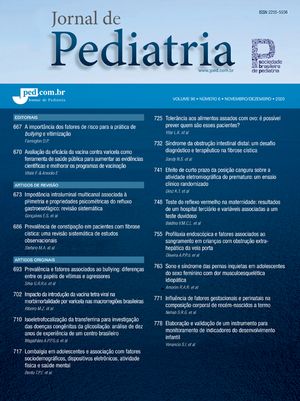
To review current concepts of physiopathology, diagnosis and treatment of diabetic ketoacidosis (DKA) in childhood, as well as preventive measures to avoid cerebral edema.
SourcesThe authors selected articles from MEDLINE with the keywords diabetes, ketoacidosis, hyperglycemia and cerebral edema, and priority was given to studies including children and that contained complete texts published in English, Portuguese or Spanish. Chapters of books published in Brazil describing the treatment of DKA in pediatric intensive care unit were also reviewed. Based on the reviewed literature and on the author’s experience, the most efficient and recommended measures for DKA management are presented.
Summary of the findingsNormal saline solution (NaCl 0.9%) has been increasingly used for fast replacement and hydration, as a substitute to diluted (hypotonic) solutions, as well as contraindication of sodium bicarbonate to repair metabolic acidosis in DKA. Regular insulin should be used as continuous infusion (0.1 IU/kg/h) without the need of a loading dose. For fast corrections of glucose oscillations, a practical scheme using two bags of electrolytic solutions is presented. Cerebral edema, its physiopathological mechanism and current treatment are reviewed.
ConclusionsUse of continuous infusion of regular insulin associated with adequate water and electrolyte replacement using isotonic solutions, besides being an effective treatment for DKA, preserves plasma osmolarity and prevents cerebral edema.
Revisar os conceitos atuais da fisiopatologia, diagnóstico e tratamento da cetoacidose diabética (CAD) na infância, assim como as medidas preventivas para evitar o edema cerebral.
Fontes dos dadosOs autores selecionaram artigos na MEDLINE com as palavras-chave diabetes, cetoacidose, hiperglicemia e edema cerebral, priorizando estudos realizados em crianças, que tenham textos completos publicados em inglês, português ou espanhol. Revisaram, ainda, capítulos de livros publicados no Brasil descrevendo o tratamento de CAD em unidade de tratamento intensivo pediátrico. Baseados na literatura revisada e em sua experiência, apresentam as medidas mais eficazes e recomendadas no manejo da CAD.
Síntese dos dadosConsolida-se cada vez mais a utilização de solução fisiológica (NaCl 0,9%) tanto na fase de reposição rápida quanto na fase de hidratação, em substituição às soluções diluídas (hipotônicas), assim como a contra-indicação do uso de bicarbonato de sódio para corrigir acidose metabólica na CAD. A insulina regular deve ser utilizada sob a forma de infusão contínua (0,1 UI/kg/h) sem a necessidade de dose de ataque. Para rápidas correções das oscilações da glicemia, é apresentado um esquema prático com duas bolsas de soluções eletrolíticas. Revisam edema cerebral, seu mecanismo fisiopatológico e o tratamento atual.
ConclusõesO uso de infusão contínua de insulina regular associada à reposição hídrica adequada com soluções isotônicas, além de tratamentos efetivos da CAD, preserva a osmolaridade plasmática e previne a ocorrência de edema cerebral.








